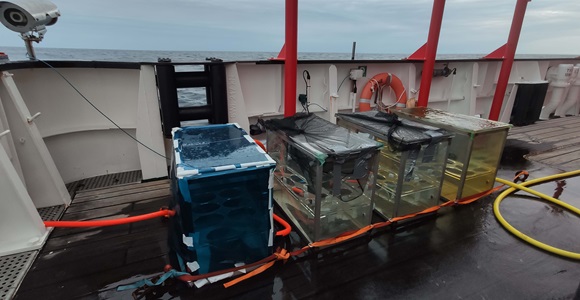
Rocks and cliffs from land will make the oceans absorb and store large amounts of CO2
The CO2 levels in the atmosphere continue to rise as we strive to reduce our emissions. Now, an international team of researchers proposes a radical solution: pour crushed stone into the sea and it will empower the water to absorb CO2 from the atmosphere.
While countries worldwide discuss how to reduce CO2 emissions into the atmosphere, a growing number of researchers are exploring methods to remove CO2 from the atmosphere.
One such researcher is marine biologist Carolin Löscher, who leads a research group at the Department of Biology and is engaged in doing experiments with the method.
In essence, the idea is to pour crushed stone into seawater or river water, initiating a chemical process that will draw CO2 from the atmosphere into the ocean, where it is stored.
The geological carbon cycle
– Few people are aware that carbon doesn't only circulate in a biological cycle. There is also a geological cycle on Earth where CO2 is removed by minerals over time, then weather and are washed into rivers and oceans where the CO2 can then sink out or chemically dissolve. This geological carbon cycle is crucial for the circulation of carbon on the planet; it largely regulates Earth’s temperature and climate. It provides a long-term storage of carbon, which is an advantage compared to the biological cycle, which binds carbon in, for example, plants, explains Carolin Löscher.
The geological carbon cycle, which works through rock weathering and transport into the oceans, operates much more slowly than the biological cycle. It takes much longer for a rock to weather than for a forest to grow.
But what if we could speed up these geological weathering processes? That's the idea behind the new research field called "ocean alkalinity enhancement."
How does it work?
Adding alkaline crushed stone to the ocean converts dissolved CO2 in seawater into bicarbonates and carbonates, which are stable forms of carbon with a lifetime of approximately 10,000 years. The resulting CO2 deficit in surface waters is quickly rebalanced via a net movement of atmospheric CO2 into the ocean, to reestablish equilibrium.
– Playing with the idea of speeding up these geological processes opens up entirely new possibilities for addressing global warming. It actually takes only a few days from pouring crushed stone into the sea for chemical processes to lead to the extraction of CO2 from the atmosphere and bind it in seawater, explains Carolin Löscher.
Various experiments are underway worldwide to test the idea, and experiences from research environments have been compiled into a "Best Practice Guide." The full name of the guide is "Guide to Best Practices in Ocean Alkalinity Enhancement Research," and it was presented at the UN climate conference COP28 in the United Arab Emirates on 2 December 2023. The guide can be found here (external link).
The relevant rock and cliff types should be alkaline, such as olivine, limestone, and dolomite. According to Carolin Löscher, these are abundantly available worldwide, and there is more than enough to make a significant contribution to removing CO2 from the atmosphere.

1 ton of stone removed 1.3 tons CO2
In one of Carolin Löscher’s experiments, she and her PhD student Jakob Bang Rønning tested the rock type olivine in an experimental river system in Scotland. The simulated river system was closed and used exclusively for the research project.
– We found that with one ton of olivine, we could remove 1.3 tons of CO2. This result takes into account the CO2 consumption of crushing and transporting the olivine, so it's a good outcome, says Carolin Löscher.
Not all oceans and river systems are equally suitable for pouring crushed stone into them, she points out. The open, deep oceans might not be ideal due to the long journey for the large quantities of crushed stones needed, and the current and water circulation may send the crushed stone to the bottom, where they would be stored instead of dissolving in seawater. There's also the legal aspect: Current legislation prohibits dumping anything in the world's oceans, even if the intentions are good.
Icelandic and Baltic waters are suitable
Instead, Löscher suggests river systems and coastal areas as suitable locations because the crushed stone is more likely to wash in and out of the riverbank or shore, giving it more time to perform its chemical job.
– It takes a couple of days from pouring crushed stone into the seawater until it has dissolved and led to the binding of CO2 in seawater. During that period, it should not sink to the bottom but it would be good if it dissolves largely, says Carolin Löscher.
Attractive areas include waters around Iceland and the Baltic Sea, where the water is more acidic than in other places and thus more suitable for receiving crushed, alkaline stone.
Pilot project on the American coast
When looking at individual countries' national waters, it is up to each nation to allow experimenting with spreading crushed in its waters. Some countries, like Germany, do not allow it, while others, such as Sweden, are more open to it.
One current pilot project is on a beach in the state of New York, USA. The task here was to restore the beach, and the authorities decided to add 5% crushed olivine to the new sand on the beach. The task now is to see how quickly the olivine sand dissolves from a beach and to monitor whether the environment is affected.
The project is led by the company Vesta. Link to the project.
Meet the researcher
Carolin Löscher is a marine biologist and associate professor at the Department of Biology and SDU Climate Cluster. Her research is supported by the Independent Research Fund Denmark, EU Horizon 2020 and a Villum Young Investigator grant.